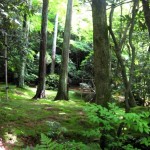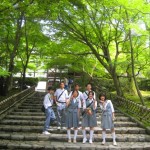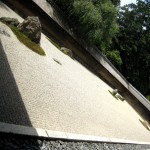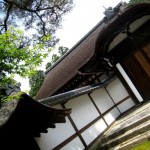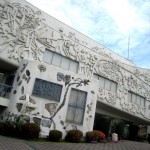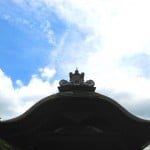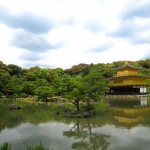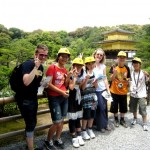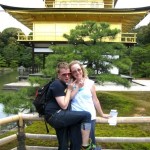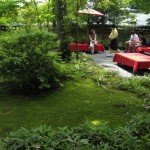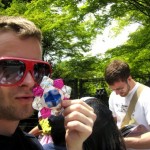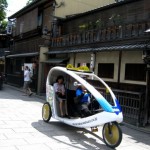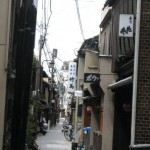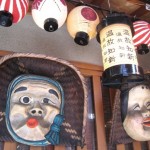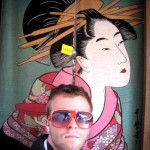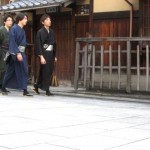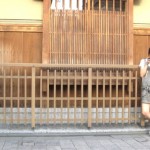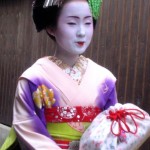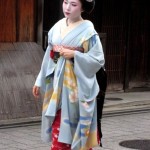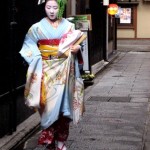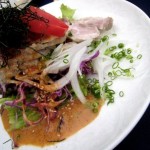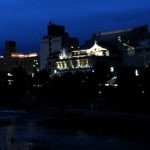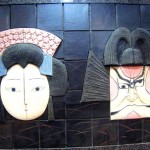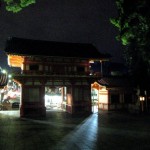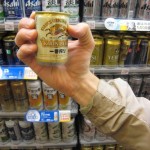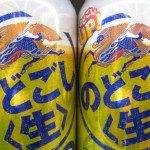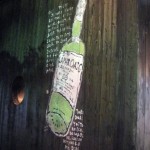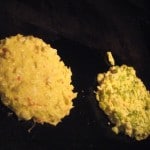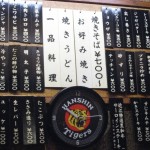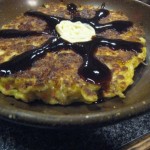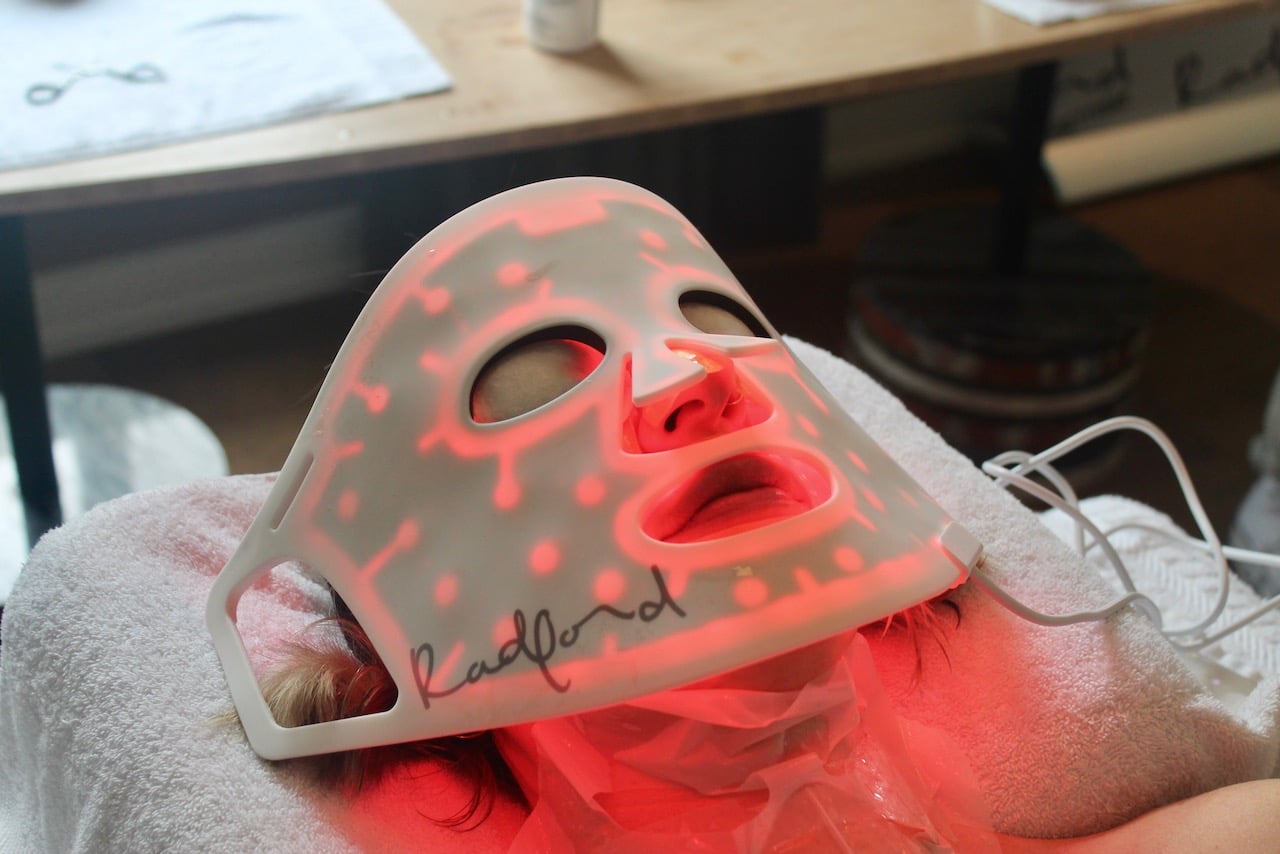The seven hour night bus to Kyoto wasn’t as arduous as I would have expected. It wasn’t exactly the lap of luxury but I managed to sleep through the whole experience and was woke up moments before the bus stopped outside Kyoto Station. I felt horribly groggy while strapping my bag to my back. I ran into the subway and headed to the tourist area of town. My hostel opened two years ago and is located in the most amazing part of town. Two minutes walk from Gion Corner, the Grand Kabuki Theater and looking right onto the river.
I took the elevator to my spacious dorm room on the 4th floor and plopped into my bed. There were several wild Australians packing their things for Tokyo. They were awkwardly boisterous. I felt as though as soon as I entered the room they all felt the need to put on their best cliché Australian personas. Two of my friends from Seoul were actually in Kyoto at the same time as me. Seeing that I am a superhero when it comes to planning my vacations I had lent them some of my info and they ended up booking this very same hostel. I walked down a floor and knocked on their door.
Tara and Stephen were just about to head out for the day so we headed out of the hostel and grabbed a bus to the north western area of the city. At a red light we stopped by a tourist shop and I laughed at a hilarious sign which read, “Hello Kitty, Official Tourist Ambassador of Japan.”
Our first stop was Ryoan-ji Temple, home of Japan’s most famous Zen Rock Garden. We walked along a nature path to the temple located at the back of the property. I was in awe at the beauty of the forest. Massive trees covered in immaculate, bright green moss. A few minutes later, after commenting on the perfection of the landscaping we noticed four ladies crouched on the path with little brooms as they swept the moss and picked pine needles off the ground. I could not help but laugh once I realized that women are paid to sweep the forest floor! This would be my first encounter with the Japanese concept that nature can be manipulated as a form of art appreciation.
We arrived at the main building, took off our shoes and tip toed on hard wood floors to the rock garden viewing area. A group of students huddled around a small scaled model of the rock garden. I found it rather funny that they all madly took pictures of this miniature model when the real thing was less than ten feet away. Surrounded by low walls, an austere arrangement of fifteen rocks sits on a bed of white gravel. It is up to each visitor to find out for himself what this unique garden signifies. The longer you gaze at it, the more varied your imagination becomes. Behind the simple temple that overlooks the rock garden is a stone washbasin called Tsukubai said to have been contributed by Tokugawa Mitsukuni in the 17th century. It bears a simple but profound four character inscription: “I learn only to be contented.”
After spending several minutes staring at rocks we exited the building and enjoyed a stroll through the many gardens and forest filled walkways. I encountered a few other moss brushers before we reached Kyoyochi Pond. This particular pond was made in the late 12th century. The pond is covered in circular lily pad communities and a small island sits in the middle. We spotted a few herons fishing for lunch and I enjoyed the shore side flower gardens which slowly tossed to and fro in the breeze.
We walked down the street towards Kyoto’s top tourist attraction, Kinkaku-ji, The Temple of the Golden Pavilion. The temple was originally built in 1397 to serve as a retirement villa for Shogun Ashikaga Yoshimitsu, and was later converted into a temple by his son. The Golden Pavilion is a three story building on the grounds of the temple which is surrounded by a magnificent Japanese strolling garden. The top two stories of the pavilion are covered with pure gold leaf and perched on top of the roof sits a sculpture of a Chinese phoenix. The brilliant yellow of Kinkaku-ji is located on the shore of Kyoko-chi (Mirror Pond) which on a clear day provides an amazing reflection of the building amongst its tree filled natural surroundings. The pond also contains several islands, one of which houses a massive stone pagoda.
Since Kyoto is the cultural capital of Japan it was no shock to see hundreds of students on sightseeing with their teachers. It became apparent that every Japanese student in middle school takes an educational trip here. I thought the Golden Pavilion was a beautiful but my fondest memories of my visit will be the hundreds of school children who would ambush us by cutting off our access to the path. We were approached by our first group of students before we even arrived at the ticket entrance. Each student is expected to interview a foreigner and ask a list of questions:
Hello my name is Yaki, I am from Tokyo, may I ask you question?
Where are you from?
What is your favorite thing about Japan?
May I take picture with you?
May I have your signature?
The following is a handout I was given from one of these school kids:
To kind people all over the world
Thank you very much for giving my students an opportunity to talk with you. Almost all the Japanese students begin to study foreign language when they enter the junior high school. But most of them very seldom have chances to talk to people who speak English or other language as their mother tongue.
If you are kind enough to speak or write to my students for a while, it will be the most precious experiences for them to study foreign language from now on. Our school excursion this year includes the visit to Kyoto and Nara. They have been studying the importance of peace and World Heritages in junior high school.
Therefore, I’d be happy if you could write a brief message about anything, such as Japanese culture, peace, world peace, and friendship in the notebooks my students have.
Welcome to Japan, and I hope you enjoy your stay!
Thanks to you.
So, for the next hour as we tried to peacefully stroll through the temple grounds we were hounded by student groups every other minute. It’s impossible to say no to these children as they are so adorable in their uniforms. We had our pictures taken with approximately fifteen different school groups and I energetically cheered and proudly displayed my peace signs for their hysterically happy teachers who took our pictures. After signing about fifty autographs I became so good at answering their questions I thought the best way to quicken up the process would be to grab one of the notebooks, fill out the questions, and have the rest of the students copy off the original. It was all very hilarious and I felt like a celebrity for most of the day. After each notebook was signed one of the students would hand us each a colourful piece origami that they had made before setting out on their trip.
I stuffed my hands in my pockets as we walked through the tourist shops near the Temple exit and realized my shorts were full of origami. The tourist shops had a wide assortment of postcards, corny Golden Pavilion key chains and traditional Japanese edible treats. Outside of the tourist shop ladies would motion you over to their table where they each sold traditional sweet rice cakes. Each of these sweet treats was filled with fruit preserves such as apricot, strawberry and peach.
We walked towards the bus station and were hounded by another group of students who shoved origami swans into our hands and insisted we sign our autographs in their notebooks. I was starting to get a bit exhausted from all of the attention and realized why so many celebrities constantly complain about their high profile lives. I can now totally relate to how the Kennedy’s feel.
Directly across the street stood a long line of vending machines. The Japanese love vending machines. You can buy anything from the typical drinks, chocolate bars, chips and cookies…to the more bizarre ones which sell fresh cut flowers, cigarettes and even underwear. I stood staring at a bright red vending machine which sold over fifteen alcoholic beverages; beer, vodka fruit juice cocktails, whisky mini bottles and wine. I could not believe that anyone could just walk up to this machine and purchase alcohol on the side of the street. Japan’s relaxed attitude towards alcohol access is rather interesting when compared to other countries such as America which is so paranoid about these matters. We each bought a peach juice spritzer from this glorious road side stand and hopped on the next passing bus.
We ran to the back bench of the bus and sat sipping our drinks as several students crammed into the seats in front of us stared back at us. I rummaged through my pockets and decided to walk up and down the aisle to hand out my recently acquired origami. It was so funny to see the faces of locals as they stared up at me entirely startled to be receiving a random origami swan from a foreigner for no reason at all. They all just smiled at me and I could tell they were just trying to stop themselves from laughing at me. Tara and I commented on the odd dynamic between the genders in Japan. We were sitting on a very busy bus but several seats were only occupied by one person when they clearly sat two. It was funny to watch men hop onto the bus looking for a seat and when they realized the only free seats were shared by a female they decided to just stand crammed on the bus holding onto the handles that precariously dangled in the air above.
We arrived back in the middle of town and walked to the entrance of Chion-in Temple which is located at the end of Marauyama Park. We were greeted by the colossal main gate, San-mon which was built in 1619 and is the largest surviving structure of its kind in Japan. After walking through the gate we found ourselves standing at the bottom of what seemed to be the worlds tallest staircase. I could barely make out the top stair and moaned a bit internally before starting the climb. Each step was made of a massive slab of rock and took some huffing and puffing to conquer. All our efforts would soon prove to be worth it.
Chion-in Temple is the headquarters of the Jodu Shu (Pure Land Sect) founded by Honen in 1133, who proclaimed that sentient beings are reborn in Amida Buddha’s Western Paradise by reciting the nembutsu, Amida Buddha’s name. The vast compounds of Chion-in include the site where Honen settled to disseminate his teachings and the site where he died.
The many buildings on the property are all the same dark brown colour with elegant traditional Japanese swept roofs. The roof beams are all carved with the family crest of the Tokugawa family: three hollyhock leaves. Another feature is the umbrella found stashed in the rafters outside the main temple. One of the architects who helped rebuild the temple placed the umbrella in the rafters to help bring rain (and thereby ward off fire). An interesting feature inside the temple is the very squeaky boards. The wooden boards were built with metal ends that rub against the metal joints they were attached too, creating a piercing noise as people step on them. This was intentionally done so that when the Tokugawa family stayed at the temple, they could detect unwanted intruders at night.
After a long day of running around the city (note that I slept on a bus the following evening) I walked up the steps leading to the main temple, passing through the massive entrance and plopped onto the ground. I spent the next thirty minutes zoning in and out of consciousness as two monks chanted and rhythmically played their brass gongs. Once I had relaxed, the chanting (which this sect of Buddhism is famous for) had set me in a state of calm and relaxation. A cool breeze swept through the ancient interior blowing through my hair. I stared up at the front of the room and watched cute little Japanese grandmothers who appeared no taller than four feet tall, tip toe up to the front bowing to pray. After spending several days around the sweet smell of incense filled Japanese shrines and temples I’ve decided that Christian churches really need to decide on a distinguishable scent.
We walked to the balcony and I stared up at the largest door I have ever seen. It appears as though a family of giants live here at night. We stared down at a small shrine located above a stone bridge straddled lily pond. All three of us laughed when we spotted a truly odd sight. Approximately thirty senior citizens crouched over gravel, wearing white gloves and holding little baskets. We walked over to them and realized they were painstakingly sifting through the path to remove pine needles, tiny leaves and other bits of unwanted debris. As we stood overlooking a bed of lily pads I couldn’t help but laugh at these people. My mother once asked me to pick weeds from our cottage gravel drive way. I thought the request was ridiculous, inhumane and purposeless. The moss sweeping ladies we had encountered earlier in the day had nothing on these perfectionists. We felt sort of bad for them so we crouched down and picked up a few pine needles before rolling our eyes and slowly walking back down the longest staircase in the world.
On the trip back to Gion we all noticed something rather unique about how the bus drivers drive in Kyoto. Whenever a bus stops to pick up new passengers at the side of the road the driver turns off the buses motor. When everyone is onboard and the doors have closed the bus engine starts back up again. We were told this is because Kyoto actively adheres to the “Kyoto Protocol” and prides itself on actively harmonizing itself with nature by reducing green house gas emissions. I stood beside the bus driver for about ten minutes to watch how he turned off the engine so frequently. All of the buses have a joystick to the left of the steering wheel which automatically turns off the engine when pushed downwards. During periods of heavy traffic drivers turn off the engine when bumper to bumper.
The district of Gion originally developed in the Middle Ages, in front of Yasaka Shrine. The district was built to accommodate the needs of travelers and visitors to the shrine. It eventually evolved to become one of the most exclusive and well known geisha districts in all of Japan. The geisha in the Gion district do not refer to themselves as geisha; instead Gion geisha use the local term geiko. While the term geisha means, “artist”, the more direct term geiko means specifically, “a woman of art.” Despite the considerable decline in the number of geisha in Gion in the last one hundred years, it remains the best place in Japan to interact with these colourful artists.
Part of this district has been declared a national historical preservation district. Gion remains dotted with old-style Japanese houses called machiya, some of which are ochaya or tea houses. These are traditional establishments where the patrons of Gion, from the samurai of old to modern day businessmen have been entertained by geiko in an exclusive manner for centuries. To this day, geiko and maiko in full regalia can still be seen in the evenings as they move about through the streets of Gion to and from their various engagements at the ochaya. There is a popular misconception that Gion was a red-light district. However, as it was a geisha district, and as geisha are entertainers, not prostitutes, Gion is not, and never was a red-light district.
We arrived in the middle of the street ready to spot geisha as they tip toe on their platform sandals in beautiful kimonos. We unfortunately had just missed a gaggle of geishas as an excited Danish tourist told us they were hurrying through the streets just moments before we arrived. I was fortunate enough to spot two geisha before we left to find a quick lunch. I had just arrived in Kyoto and decided to spend an early evening later in the week camped out in Gion in order to take some classic Geisha shots with my camera.
I was beyond elated when we found a huge Okonomiyaki house on the corner of the main street. The restaurant is clearly geared for tourist as it has a prominent statue of a Japanese man running in his kimono as a dog grabs his underwear and pulls them bellow his knees. His man business was indeed visible. We sat down in one of the most hilarious restaurant dining rooms in the world. Each table featured two mannequins dressed in kimono who appear to be part of your dining party. The walls were covered in crude and rude little cartoons featuring rather sexualized depictions of samurai and geisha. We were handed a huge menu which featured only one item. Our waitress laughed and told us, “this restaurant only sells one thing and that is our okonomiyaki!” She rushed off to the front of the restaurant to place our orders and I followed her to watch the chef at the front of the restaurant flipping Japanese pancakes.
Okonomiyaki consists of a pan-fried batter cake and various ingredients. Okonomi means “what you like” and yaki means “grilled”; thus the name of this dish means “cook what you like.” In Japan, okonomiyaki is mainly associated with the Kansai area as it was invented in Osaka (just thirty minutes from Kyoto). Toppings and batters tend to vary according to region.
The traditional Osaka style pancake is made up of a batter of flour, grated yam, dashi, eggs and shredded cabbage. Toppings include green onion, bacon, octopus, squid, shrimp, vegetables and kimchi. The cooked pancake is then topped with katsuobushi fish flakes, sweet mayonnaise, pickled ginger and a sweet Worcestershire sauce. It is sometimes compared to an omelet, pizza or pancake and may be referred to as Osaka Soul Food. This particular restaurant serves a Kyoto style pancake which has a thinner base much like a French crepe which we devoured in minutes.
On our walk back to the hostel we stopped off at the cities flagship Starbucks store. The coffee shop sold a wild assortment of Starbucks/Kyoto paraphernalia such as Starbucks Coffee mugs which feature beautiful temple silhouettes, cherry blossoms and strolling geisha in kimono. We sat down with our coffee’s and spent the next several minutes discussing our action packed day of sight seeing. Throughout the day, whenever we happened upon a beautiful historic sight I’d jokingly chirp, “well you certainly couldn’t ask for more!” And we’d all chime in, “well a pirate ship would be interesting.” Japan’s temples and gardens are seriously lacking adequate pirate paraphernalia.
We gathered on the fifth floor of the hostel where a small patio looks out over the river and main intersection of Gion. Staring across the river we spotted a restaurant with approximately ten women dressed in indigo blue kimono sitting beside businessmen as they ate their meals cross legged on tatami mats. It was amazing to watch these women in their kimono as they attentively poured drinks for the men, served the table food and scurried around the outdoor patio.
As the sun started to fall across the horizon, and the cities street lights began to glow we walked across the bridge in front of our hostel in search of a restaurant. Along the river hundreds of fine dining restaurants sit on stilts. Guests sit outside on patios so you can try and peak to see what sorts of food are available at each restaurant based on what people are eating outside. I popped into a restaurant directly beside the bridge called Manzara-Tei which had a beautiful open kitchen with several large bowls of Japanese comfort foods sitting on the sill.
We were seated on the patio directly in front of the cities palatial Kabuki Theater. We were handed woolen shawls to keep warm and flicked through the menu for the next few minutes. I decided to splurge on my meal and ordered the following:
Domaine de Fentedit Chardonnay
Pumpkin and Cream risotto stuffed Spring Rolls
Shaved Pork Loin with spicy sesame dressing
Duck Breast with sweet miso mayonnaise
For the next two hours we sat chatting about life as we nibbled on the food before us. Poor Stephen expected the service to be similar to home where each person is served their meals at the same time. The waiters and waitresses stared and gossiped about us the entire meal as only one person would touch the food on the table. Two of my dishes were the first to arrive on the table so our famished friend Stephen sat there desperately waiting for his food to arrive. The waiters spoke very little English so instead of explaining to us that we were supposed to eat each dish together he would just smile and replace our small luncheon plates on a regular basis to indicate that everyone was supposed to be eating from the main dish. As the meal came to a close I held my last glass of wine over the river and watched the moon flicker through my glass.
We spent the next hour walking up Gion’s main street, stopping at convenience stores along the way to grab two dollar cans of Asashi Beer. One of the side streets is a bit sketchy (as we soon found out). The street is lined with Japanese men in suits. After walking a few minutes down the street we suddenly realized we were being stared at by members of the Japanese Mafia, The Yakuza. These are members of traditional organized crime groups in Japan. Today, the Yakuza are one of the largest crime organizations in the world. In Japan, as of 2005, there are 86 300 known members. The biggest yakuza umbrella group, the Yamaguchi-gumi emerged in the Kanasai region during the post War era. American occupation forces fought against them in vain and conceded defeat in 1950.
The Yakuza also practice several rituals. Yubitsume, or finger cutting is a form of penance or apology. Upon a first offense, the transgressor must cut off the tip of his left little finger and hand the severed portion to his boss. Its origin stems from the traditional way of holding a Japanese sword. The bottom three fingers of each hand are used to grip the sword tightly, with the thumb and index fingers slightly loose. The removal of digits, starting with the little finger moving up the hand to the index finger progressively weakens a person’s sword grip. The idea is that a person with a weak sword grip then has to rely more o the group for protection. When the British cartoon Bob the Builder was first considered for import to Japan, there were plans in place to add an extra digit to each of the little characters four fingered hands to avoid scaring children.
Many Yakuza have full body tattoos. These tattoos, known as irezumi in Japan are still often hand poked, that is, the ink is inserted beneath the skin using non-electrical, hand-made and hand held tools with needles of sharpened bamboo or steel.
Throughout Japan tattoos have become a symbol for organized crime, violence and fear. Signs which read “no tattoos allowed” can be found at bars and traditional Japanese spas because the sight of tattoos scare patrons. So, as we walked down the street and realized several men in suits were staring at us, one of which was following closely behind us as we walked down the street, it became apparent that we had walked into the wrong area of town. We “high tailed it out of there.”
We arrived at the entrance of Yasaka Shrine being sure to prance up the steps in a flamboyant manner. The Shrine was originally built in 656. In 869 the mikoshi (portable shrines) of this Shrine were paraded through the streets of Kyoto to ward of an epidemic that had hit the city. This was the beginning of the Gion Matsuri, and annual festival which has become world famous.
The Shrine is best seen at night as thousands of glowing lanterns illuminate the complex. We walked up a pathway lined with brightly lit antique lanterns before arriving at the main temple. The entire shrine is painted in bright orange paint which contrasted nicely with the several hundred school children wearing similar coloured back packs. After several glasses of wine at dinner, I was on fire. I ran up to the students with raised peace signs and screamed, “picture, picture with famous white people!” They all screamed and gathered around us for a group shot. The accompanying teachers were laughing hysterically as we held our Asashi Beers over our head and cheered with the children. Our short visit to Yasaka Shrine would probably forever be my most memorable moment in Japan. On a pleasant post delicious dinner high, strolling through a brilliantly coloured shrine covered in thousands of glowing lights…it was here that we were hounded by hundreds of little children who hugged us, gave us high five’s and said, “I love you!”
We walked past Gion Corner where a famous bronze statue of an elegant geisha holds a sharp samurai sword over her heard. A local jazz quartet sat around her shadow playing for pennies at the entrance to the bridge. The ambiance was ever so romantic. The sound of live jazz flew across the full moon as we walked over the cities main bridge. We hung a left and walked down a few steps to the rivers boardwalk. We sat beside a monk and stared out at the many lights which flickered over the river. I turned my head and stared down the river to my left. Hundreds of stilts emerged from the shore, propping up restaurant patios above. I could hear the chitter chatter and laughter of people enjoying their meals over our heads.
After chilling out at the river for an hour we walked back up to the main street and turned quickly down the cities famed Pontocho street. Like Gion, Pontocho is famous for the preservation of traditional architecture and entertainment. Pontocho centers around one long, narrow, cobbled alley running from Shijo-dori to Sanjo-dori one block west of the Kamo River. This is also the traditional location of the start of kabuki, and a statue of famed actor Okuni, still stands on the opposite side of the river. Today the area, lit by traditional lanterns at night, contains a mix of very expensive restaurants, geisha houses, tea houses and bars. Kyoto is full of gems! Walking down this street makes you feel as though you may be standing on the film set for Memoirs of a Geisha.
The next street beyond Pontocho would become my favorite spot to dine out in the city over the next few days. In the middle of the street runs a lily filled stream with several adorable bridges. Many of the restaurants on the street open their large windows at night so you can peak into their dining rooms and watch sushi chefs interacting with their guests.
We stopped at what one would call a “Japanese Greasy Spoon.” Two little Japanese girls worked at this restaurant and were incredibly excited when we walked in just after midnight. We sat down at a table and each ordered a traditional kanasai oknomiyaki. I ordered mine with crispy bacon and minutes later I had a massive plate of the best Japanese pancake that I had ever tasted. While devouring our late night snacks we stared up at the bars television which played a ridiculously funny Japanese comedy show.
We all commented that Japan is a refreshing change from Korea as it is much more liberal. Even on television women and men laugh and smile and show their teeth. In Korea, this same television show would feature participants who would be covering their mouths with their hands as they giggled. I find it truly bizarre that any culture would encourage people to cover their laughter. Probably the most beautiful expression anyone can give the world. Hiding happiness just seems so ridiculous to me. We couldn’t help but laugh at these Japanese contestants as their white teeth flashed on the screen above.
We wondered over the bridge and back to our hostel after a perfectly long and satisfying introduction to the colourful city of Kyoto.





